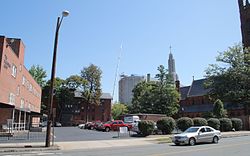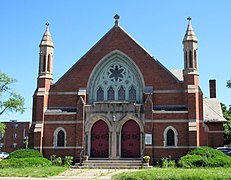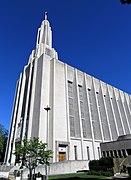United States historic place
| Asylum Avenue District | |
| U.S. National Register of Historic Places | |
| U.S. Historic district | |
 | |
  | |
| Location | Asylum and Farmington Aves., and Sigourney St., Hartford, Connecticut |
|---|---|
| Coordinates | 41°46′10″N 72°41′36″W / 41.76944°N 72.69333°W / 41.76944; -72.69333 |
| Area | 25 acres (10 ha) |
| Architect | Keely, Patrick C.; Multiple |
| Architectural style | Italianate |
| MPS | Asylum Hill MRA |
| NRHP reference No. | 79002672 |
| Added to NRHP | November 29, 1979 |
The Asylum Avenue District encompasses the institutional core of the Asylum Hill neighborhood of Hartford, Connecticut. Located just west of Downtown Hartford across Interstate 84, it includes four churches, a school, and a handful of adjacent 19th-century residences. It was listed on the National Register of Historic Places in 1979.
Description and history
The Asylum Avenue District is centered on a stretch of Sigourney Street, between Asylum and Farmington Avenues, both major arteries leading west from downtown Hartford. Extending east and west from that road are the institutional buildings that make up the heart of Asylum Hill. The northeastern corner of the district is marked by the Asylum Hill Congregational Church, a Gothic Revival brownstone built in 1865. It is a rare example of a Congregational church designed by Patrick C. Keely, most of whose work was for the Roman Catholic Church. At the southeastern corner is the Cathedral of St. Joseph, the cathedral church of the Roman Catholic Archdiocese of Hartford. It was built in the early 1960s to a design by Eggers & Higgins in the International style, replacing a Gothic brownstone designed by Keely that was destroyed by fire.
West of St. Joseph's stands the Trinity Episcopal Church, built in 1892 in the English Country Church style out of red brick. Across Sigourney Street from Trinity is the campus of the West Middle School, which includes a 1930 Georgian Revival building and an older Romanesque structure. At the northwestern corner of the district stands the Asylum Avenue Baptist Church, A Collegiate Gothic building built in 1931 on the site of an 1872 church. Between It and the Congregational Church are a row of fine houses dating to the mid-to-late 19th century Victorian period.
Prior to its development in the mid-19th-century, the Asylum Hill area was mostly farmland owned by the locally prominent Goodwin family. Francis Goodwin was rector of Trinity Church, and some of the Goodwin land was purchased for the construction of St. Joseph's. The Baptist Church came about through the initiative of Jonathan Niles, for whom Niles Street is named.
-
 Asylum Hill Congregational Church
Asylum Hill Congregational Church
-
 Trinity Episcopal Church
Trinity Episcopal Church
-
 Asylum Avenue Baptist Church
Asylum Avenue Baptist Church
-
 Cathedral of St. Joseph
Cathedral of St. Joseph
See also
References
- ^ "National Register Information System". National Register of Historic Places. National Park Service. July 9, 2010.
- ^ "NRHP nomination for Asylum Avenue District". National Park Service. Retrieved April 6, 2017.
| U.S. National Register of Historic Places | |
|---|---|
| Topics | |
| Lists by state |
|
| Lists by insular areas | |
| Lists by associated state | |
| Other areas | |
| Related | |